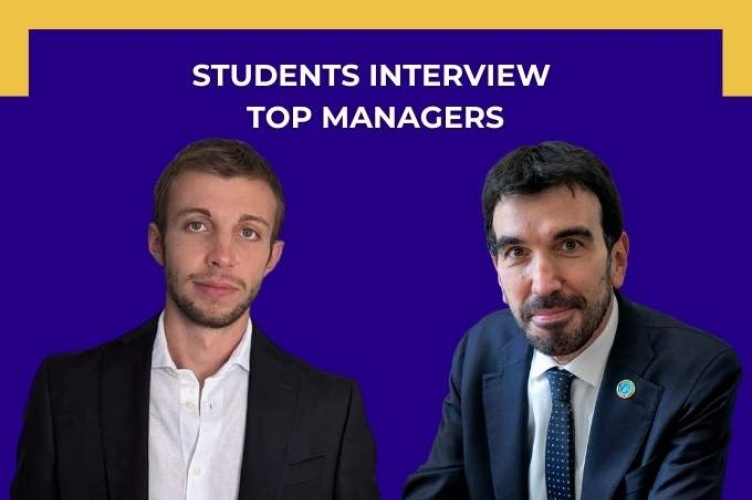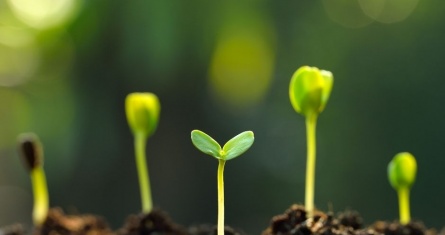The zero-hunger target, the impact of climate change, wars and the pandemic on the agri-food system and its megatrends are some of the crucial themes Vittorio Cecchini Manara, ESCP’s Master in International Food and Beverage Management student, had the unique opportunity to discuss with Maurizio Martina, Assistant Director-General – Food and Agriculture Organization of the United Nations (FAO).
Maurizio Martina was one of the guest speakers of the 2022 Academic Year Opening Ceremony, which took place in Turin on September 30th. This summer, ESCP Turin Campus launched a contest among its incoming students for the third year in a row: to propose questions they would like to ask the event’s Guest Speakers. Many incoming students from the MSc in IFBM proposed questions for Maurizio Martina. Among those who sent the most interesting contributions, Vittorio Cecchini Manara has been selected to interview the Assistant Director-General of FAO, the United Nations organization that leads international efforts to defeat hunger and improve nutrition and food security.
Vittorio Cecchini Manara: In 2015, one of the many ambitious objectives of the 2030 Agenda for Sustainable Development was the Hunger 0 objective, with the aim of ending hunger and food insecurity by the end of this decade. Today this goal seems unattainable. According to the latest FAO report, food insecurity is increasing. In addition, it should be considered that the war in Ukraine broke out after the report’s publication, having additional serious impact on food insecurity around the world, and in particular in the poorest countries of Africa and the Middle East. In 2021, the number of people suffering from hunger on the planet reached 828 million, this is an increase of about 46 million people since 2020 and 150 million since the outbreak of the Covid19 pandemic.
When do you think that the ambitious goal set in 2015 can actually be achieved and what do you think have been the main reasons on the global level in the past seven years that have brought world hunger to increase?
Maurizio Martina: We are at a critical moment in time. We are witnessing a convergence of factors that, if ignored, threaten to prevent us from ending global hunger and malnutrition in all its forms. Our agri-food systems are not delivering the food security and nutrition outcomes we want to achieve.
Current projections estimate that over 650 million people may still be hungry in 2030. Clearly, very far from SDG2 zero hunger target.
In particular, for the last five years, we have seen a spike in global levels of acute hunger. Unfortunately, the projection for 2022 is of further deterioration, including places with catastrophic food insecurity.
There are famine risks in Yemen, Somalia, South Sudan and Afghanistan.
The main drivers for the increase of hunger are conflicts, climate change and economic crisis.
We need to do things differently than in the past and our agri-food systems need to be transformed. This means that we need to adopt effective measures and integrated frameworks and policies that address trade, investments and management of natural resources.
The way forward to eradicate hunger and reduce poverty must pass through multilateral cooperation and dialogue.
VCM: Right now, we are in a perfect storm, with the impact of climate change, the consequences of the Ukraine war and the economic shocks caused by COVID-19. The model of globalisation we have built has proven fragile, bringing different consequences to the North and the South of the world, but generally affecting everyone. How do you think the global supply chain should be rethought and how do you think globalisation will be re-organised in the future?
MM: Several overarching key drivers and megatrends have shaped our current agri-food systems: population dynamics and urbanisation; economic growth, structural transformation, and macro-economic stability; cross-country interdependencies; geopolitical instability and climate change.
In the past few years, we noticed how easily today's global and complex agri-food systems can be compromised. I believe we are at the beginning of a new phase of globalisation.
We are experiencing a new global order that many describe as a new "selective globalisation", divided into large geographical areas, aimed at making exchanges more efficient according to the different local characteristics.
It requires a new balance, with two main drivers: open at the world and strengthened autonomy in terms of procurement of basic food products.
These two elements must necessarily be kept in balance.
And it would be a serious mistake to think that the first approach, open markets, is sufficient without being autonomous on certain productions. As it would be a mistake to close borders following extreme autarchic positions.
In summary, we need more autonomy without abandoning a global trade guided by strong and fair rules.
VCM: In several conferences you stated how food security depends on agriculture, environment and food production. These three concepts affect each other, with the environmental turn passing largely through an agricultural turn.
How do you think the world agricultural model should be rethought and, having been Minister of Agriculture in Italy, how do you think the agricultural-food model in Italy should evolve to consider itself strong and sustainable in all its forms?
MM: It is evident that our agri-food systems are failing us. Beyond hunger, nearly one in three people in the world were affected by moderate or severe food insecurity in 2020.
The increase from 2019 to 2020 was equal to that of the previous five years combined. Child stunting remains unacceptably high, and overweight and obesity continues to increase in rich and poor countries alike. Our food systems are generating severe human, economic and environmental costs that run into the trillions of dollars.
However, we know what must be done by 2030: reduce undernourishment, ensure affordable healthy diets, reduce overweight, obesity and child stunting, reduce poverty and inequalities, while improving management of natural resources.
To transform agri-food systems and ensure they are more resilient, inclusive, and sustainable we must take action across multiple sectors.
First, we need to increase agricultural assistance and increase local production of nutritious food.
Second, more investments in agri-food systems with policies that increase productivity and protect natural resources. Growth in the agricultural sector is key to reducing poverty and hunger in many low- and middle-income countries.
Third, better management of natural resources to ensure better and more efficient use of outputs and inputs: we must produce more (and better), with less. Less water, more efficient use of fertilisers and reducing food losses and waste that could currently feed well over 1.2 billion people.
Finally, apply science and innovation to renew our agri-food systems to address the agriculture-climate change-food security nexus. Science and innovation are essential to finding solutions to the challenges posed by climate change.
VCM: Unfortunately, this summer we have had clear glimpses of the climate of the future, with extreme drought putting great strain on the agricultural systems in a multitude of countries. Where do you think climate change will have the greatest impact and how do you think the transition to Agriculture 4.0 practices can be implemented more quickly to limit the damage of climate change?
MM: Food highly depends on climatic factors, and climate change hits fragile countries the most.
We have found that there is a very evident overlap in the map of planetary hunger with the map of climatic transformations. The latter are already radically changing the conditions of the agri-food systems on the planet. And to preserve our planet we need to achieve carbon and land degradation neutrality, increase the efficiency in the use of water for agriculture, and we need to achieve the Paris Agreement target of reducing greenhouse gas (GHG) emissions to limit global climate warming to between 1.5 and 2.0 degrees Celsius (°C).
The issue must be tackled simultaneously on two levels: on the one hand, with "emergency" choices in the very short term, and on the other, build a much broader strategic horizon.
For this reason, FAO launched its own strategy for climate change adopted in June.
This is a specific Plan, divided for each large geographical area of the planet, to support and guide the changes necessary to define new agricultural models compatible with the climate issues we are experiencing. This is not an easy operation, but it is absolutely necessary and urgent.
Fortunately, there are numerous good practices that can be taken as examples, practices that demonstrate that changing the agricultural model can be a valid response to climate change. But these virtuous experiences must necessarily also be accompanied by choices made by public institutions.
VCM: Ukraine has always been called the “granary of Europe”, and together with Russia, is one of the main producers of several key products such as sunflower oil (52% of world production) and fertilisers. This war has further strained the world supply chain, just recently impacted by covid, leading to ever-increasing inflation in the food industry.
What do you imagine the situation to be a year from now? How do you think the problem can evolve at a geopolitical level and do you fear that several EU countries may revise their food sovereignty by blocking exports to other countries?
MM: Our global simulation models are being used to assess the impacts of the crises the world is facing. Recent Outlooks and scenario simulations have helped us to better understand the consequences of the COVID-19 pandemic.
Now we are working together to provide critical assessments of the impact of the war in Ukraine on global agricultural markets and food security.
We are witnessing severe food, feed, fuel and fertiliser price shocks, given the importance of the Russian Federation and Ukraine in these markets. These price increases come on top of already high prices caused by strong global demand and supply constraints.
Because of the war in Ukraine, in addition to the many conflicts around the world, 19 million additional people could face chronic hunger globally in 2023, as the reduction in exports from Russia and Ukraine means lower food availability worldwide.
Time is short to prevent a wider food security crisis in 2023.
Declining fertiliser affordability and rising export restrictions, not only in Europe, can worsen the medium-term outlook for food, especially if they persist into the next planting season.
Besides wheat, maize and vegetable oils, the challenge could extend to other staples, especially rice, affecting billions of people. Bottom line, this year it is an issue of access, next year it could be a crisis of availability. To avoid this, it is important to keep our global trade system open and ensure that agri-food exports are not restricted or taxed.
If you missed the 2022 Opening Ceremony live event and Maurizio Martina’s speech, you could catch up on YouTube.
Campus



